Author Archives: Raven
Angak, Hopi rain kachina
Ahöla Kachina, also known as Ahul, opens the mid-winter Powamu ceremony
The Ahöla Kachina, also known as Ahul, is a spirit being, embodied by a man, in Hopi religion.
Ahöla is one of the important chief katsinam for First and Second Mesas because he opens the mid-winter Powamu ceremony, sometimes called the Bean Planting Festival, officially beginning Katsina season. Ahöla Kachina, also known as Ahul, opens the mid-winter Powamu ceremony »»
Leslie Marmon Silko: A Native American Writer of Distinction
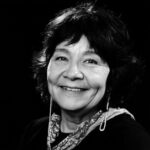
Leslie Marmon Silko is a Laguna Pueblo Native American writer who is best known for her novels, short stories, and poetry. She is one of the most important figures in Native American literature, and her work has been praised for its lyrical beauty, its complex exploration of Native American culture and history, and its political activism. Leslie Marmon Silko: A Native American Writer of Distinction »»
Sinixt or Lake Indians are now part of the Confederated Tribes of the Colville Reservation
Today the Sinixt, or Lake Indians, as they are also known, live primarily on the Colville Indian Reservation in Washington State, where they form part of the Sinixt, or Lake Indians, which is recognized by the United States government as an American Indian Tribe.
A few Sinixt live in their traditional West Kootenay territory, particularly the Slocan Valley. They are no longer legally recognized by the Canadian government.
Most Sinixt or Lake indians are now part of the Colville tribe in Washington state, but once roamed both Washington and British Columbia, Canada.
In Canada, this tribe has been ‘officially’ declared distinct. They are now one of the twelve bands or tribes that make up the federally recognized Confederated Tribes of the Colville Reservation, and are fighting to reclaim their traditional status in Canada. Sinixt or Lake Indians are now part of the Confederated Tribes of the Colville Reservation »»
Graham Greene quick profile
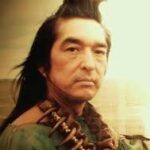
Graham Greene (born June 22, 1952) is a Canadian actor who has worked on stage, in film, and in TV productions in Canada, England, and the United States.
Greene is an Oneida, born in Ohsweken on the Six Nations Reserve in Ontario, the son of Lillian and John Greene, who was an ambulance driver and maintenance man. Today, Graham Green is one of the most prolific Native American actors in both film and television.
Although Graham Greene worked for many years as a supporting actor in stage plays and on television, Greene first became famous as an actor for his role of Kicking Bird in Kevin Costner’s 1990 film Dances With Wolves. Greene received an Academy Award nomination for this role. Graham Greene quick profile »»
Truth and consequences on the reservation–the Elouise Cobell story
Elouise Cobell heard the stories for years: the government was cheating Native Americans on payments for land rights. She took up the cause, and now the Blackfoot Indians are poised to reap billions.
In Blackfoot country, passing down stories from one generation to the next is an intricate part of tribal culture. The people who live here at the foot of the Montana Rockies pride themselves on the accuracy of this oral tradition.
In the spring, when the geese have returned and the first rumble of thunder has rolled over the land, the Blackfeet begin a series of sacred ceremonies in which the stories they tell must never be embroidered, lest they be colored over time. Truth, they say, is the core of their history. Truth and consequences on the reservation–the Elouise Cobell story »»
The First Butterflies, an Ojibwe legend

Long ago, when human twins were born to Spirit Woman, she relied on the animals to help her take care of them. All the animals loved the first human babies and did everything they could do to help them.
The dog watched over them. The bear gave his fur to keep them warm. The wolf hunted for them. The doe provided them with milk. The beaver and the muskrat bathed them. The birds sang lullabies to them.\
The dog was an excellent guardian. The twins had only to cry out and the dog jumped to his feet, his tail wagging. When he found out what was troubling the children, he set it right- or called someone else who could help. The First Butterflies, an Ojibwe legend »»
Native American Pottery
Fired clay is the only material on earth that does not change with time.
In the past, the skill of pottery making was associated with Neolithic culture, with the development of agriculture and settled communities (6000 – 4000 BCE). However, pottery was being made by Asian hunter-gatherers 13,000 years ago.
By 4000 – 3000 BCE, Chinese and Middle Eastern potters were using potter’s wheels and closed kilns. By the 7th century BCE Chinese potters of the T’ang dynasty were producing unrivaled glazed earthenware as well as porcelain. Greek potters were exporting their characteristic black figure pottery and in Meso-America the Olmecs were creating unglazed tripod pottery.
Although ceramics making began in Central America around 9000 BCE, the skill did not arrive in North America until 4000 BCE when Indians of the Southeast first took it up, about the same time the dog was domesticated and agriculture and a more sedentary life style became common in this area. Native American Pottery »»
The Mishewal Wappo Tribe of Alexander
The Mishewal Wappo Tribe of Alexander Valley headqurtered at 2275 Silk Road,Windsor, CA 95492 is the last remaining Wappo Tribe in existence, The tribe now claims 357 enrolled members, all lineal descendants of 10 families who lived on the reservation in 1935.
The Wappo Indians are asking the government to restore their tribal status, benefits and historic land rights.
The Wappo are a group of three similar-speaking people: the northern Mishewal (Warrior People) of Alexander Valley and southern Lake County; the central Mutistul group of Knights Valley and eastern Sonoma County; and the Mayakmah (Water Going Out Place) of the southern tidal areas of Napa and Sonoma Valleys. The Mishewal Wappo Tribe of Alexander »»
Confederated Tribes and Bands of the Yakama Nation
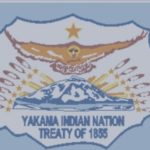
The Confederated Tribes and Bands of the Yakama Nation have lived in Central and South Central Washington since time immemorial. The lands of the Yakama extended in all directions along the Cascade Mountain Range to the Columbia River and beyond. Tribal elders say their distance of travel sometimes took them as far north as Canada and as far south as California.
The Yakama, formerly spelled Yakima, self-name Waptailmim (“People of the Narrow River”), are the primary band of the Confederated Tribes and Bands of the Yakama Nation. A North American Indian tribe that lived along the Columbia, Yakima, and Wenatchee rivers in what is now the south-central region of the U.S. state of Washington, the Yakama were hunters, fishermen, and gatherers who relied on the land for their livelihoods.
The Yakama people have a long and complex history that includes both conflict and cooperation with European settlers. Confederated Tribes and Bands of the Yakama Nation »»
The Blackfoot Language: A Window into the Culture and History of the Blackfoot People
The Blackfoot language is a member of the Algonquian language family and is spoken by the Blackfoot people in North America. It is an indigenous language that is predominantly spoken in Alberta, Canada, and also in Montana, USA.
The Blackfoot language has two main dialects: Siksika and Kainai. It is an endangered language with only a few thousand speakers remaining, mainly elderly people. The Blackfoot Language: A Window into the Culture and History of the Blackfoot People »»
The Maliseet Language: A Living Legacy of Eastern Algonquian Traditions
The Maliseet language, also known as Wolastoqey or Amalecite, is an Eastern Algonquian language spoken by the Maliseet people in New Brunswick, Canada, and in Maine, USA. The Maliseet Language: A Living Legacy of Eastern Algonquian Traditions »»
Moxus: A Chief of the Abnaki
Moxus, also known as Agamagus, was a chief of the Abnaki tribe. He was the first signer of the Treaty of 1699 and the successor of Madokawandu. He is remembered today for his contributions and achievements in early Abenaki conflicts and negotiations of several important treaties. Moxus: A Chief of the Abnaki »»
Frank Longtoe ( 1871-1949), Abenaki, was known as “The Masked Marvel”
Frank Longtoe, also known as the “Masked Marvel,” was a Pocket Billiards Player of Abenaki decent, who always wore a mask and was never photographed without his mask. The masked Marvel accepted all challenges including Ralph Greenleaf.
In 1931, Ripley’s Believe It Or Not featured him as “The Best Player in the World,” winning 1500 out of 1512 games over a 3 years period.
The masked marvel was known to keep company with “Kid Sheehan.” Frank Sheehan (1885-1952) was another Abenaki, who was a Bantam weight Prizefighter. His boxed in 409 bouts from 1900-1925, winning many if not most of his fights in Massachusetts, Vermont, New York, Nova Scotia and Quebec, often accepting matches as a way to visit his Abenaki relatives. Frank Longtoe ( 1871-1949), Abenaki, was known as “The Masked Marvel” »»
Louis Cook (1737-1814) was a chief and warrior of the Seven Nations
The Seven Nations, also known as the Seven Fires Council, was a confederation of seven Algonquin-speaking tribes that lived in the northeastern region of North America. The member tribes were the Anishinaabe (Ojibwe), Odawa (Ottawa), and Potawatomi, who were known as the Three Fires, as well as the Nipissing, Mississaugas, Algonquin, and Wendat (Huron).
Together, these tribes formed a powerful political and military alliance that helped them to resist colonial forces and maintain their sovereignty over their traditional lands.
Louis Cook (1737-1814) was a prominent chief and warrior of the Seven Nations, known for his leadership skills and bravery in battle. He was born in what is now known as Canada, to a coloured man & his mother was an Indian woman of the Abaniquis tribe. Louis Cook (1737-1814) was a chief and warrior of the Seven Nations »»
Graylock, Western Abenaki Missisquoi chief of Woronoco/Pocomtuc ancestry
Graylock (c. 1670 to 1750) was a Western Abenaki Missisquoi chief of Woronoco/Pocomtuc ancestry, born near Westfield, Massachusetts. Graylock, Western Abenaki Missisquoi chief of Woronoco/Pocomtuc ancestry »»
Cedarville Rancheria
The Cedarville Rancheria is a federally recognized tribe of Northern Paiute people in Modoc County, California. The tribe is made up of descendants of the Northern Paiute, Achomawi and Atsugewi peoples.
Official Tribal Name: Cedarville Rancheria
Address: 300 West 1st Street, Alturas, CA 96101
Phone: 530.233.3969
Fax: 530-233-4776
Email: cedranch@citlink.net
Official Website: www.citlink.net/~cedranch/Cedarville_Rancheria/
Recognition Status: Federally Recognized
Traditional Names of the Tribes Included in Cedarville Rancheria and Traditional Meanings:
Cedarville Rancheria is made up of the descendants of several indigenous tribes who have lived in the region for thousands of years. These tribes have their own unique cultures, traditions, and languages. The traditional names of the tribes included in Cedarville Rancheria are:
-
Kosealekte – This tribe was known as the Goose Lake People. The name comes from their proximity to Goose Lake, a large body of water located near the California-Oregon border.
-
Klamath – The Klamath tribe was one of the largest and most powerful tribes in the region. The name Klamath means “people of the lake” and refers to the tribe’s close relationship with Upper Klamath Lake.
-
Modoc – The Modoc tribe was known for their fierce warrior culture and their ability to adapt to their environment. The name Modoc means “southern people” and refers to their location in southern Oregon and northern California.
-
Paiute – The Paiute tribe is a group of Native American people who have lived in the Great Basin region for thousands of years. The name Paiute means “true Ute” and refers to their linguistic and cultural similarities with the Ute people.
-
Shasta – The Shasta tribe was known for their unique language and culture. The name Shasta means “those who live in the mountains” and refers to their location in the Cascade Range.
Region: California
State(s) Today: California
Traditional Territory:
The tribe’s historical territory includes parts of northeastern California, southern Oregon, and western Nevada. The traditional territory of the Cedarville Rancheria tribe is located in California’s Modoc County. Their traditional territory encompasses most of the county.
The tribe has a long history of occupying this region, and they have always been closely tied to the landscape and the resources it provides.
The traditional territory includes several mountain ranges, including the Warner Mountains and the Modoc Plateau. The area also includes several rivers and streams, including the Pit River, Lost River, and the Rush Creek.
This region is also home to many lakes, including Lake Surprise and Lake Almanor, as well as several wetlands. The traditional territory includes several types of vegetation, including oak woodlands, sagebrush steppe, juniper forests, and ponderosa pine forests.
The Cedarville Rancheria tribe has historically hunted and gathered food in this region for centuries. They have also used the area for spiritual ceremonies and gatherings. Today, the tribe is focused on preserving their culture and protecting their ancestral lands from development.
Confederacy: Paiute
Treaties:
The Cedarville Rancheria did not sign any of the 371 treaties with the US Government.
Reservations:
Cedarville Rancheria and Off-Reservation Trust Land
The Cedarville Rancheria is a small reservation land located near the city of Cedarville, California and it is the only federally recognized tribal land in Modoc County.
Land Area: The reservation consists of approximately 26.58 acres of land held in trust by the federal government for the exclusive use of the Cedarville Rancheria tribe. The tribe uses this land for a variety of purposes, including housing, community facilities, and government operations.
Tribal Headquarters: Near Cedarville, California.
Time Zone: Pacific Time
Population at Contact:
At the time of European contact, the population of the tribes included in the Cedarville Rancheria is not clear. However, the Modoc people, who are one of the tribes included in the Cedarville Rancheria, are estimated to have had a population of around 3,000 prior to contact with Europeans.
Registered Population Today: 35
Tribal Enrollment Requirements:
- The applicant must be a lineal descendant of an individual who appears on the tribe’s base roll, which was established in 1979.
- The applicant must provide documentation proving their descent from the base roll ancestor.
- The applicant must have a degree of Indian blood that is equal to or greater than 1/16.
- The applicant must not be enrolled in another federally recognized tribe.
Once an individual meets these requirements, they may apply for enrollment in the Cedarville Rancheria. The enrollment process includes a review of the application and supporting documentation by the tribe’s enrollment committee, as well as a vote by the tribal council.
Genealogy Resources:
Here are some resources you may find helpful:
-
Cedarville Rancheria Tribal Office: The Cedarville Rancheria Tribal Office may be able to provide you with information about your family history if you are a member or descendant of the tribe. Contact the office to inquire about available resources.
-
Bureau of Indian Affairs: The Bureau of Indian Affairs (BIA) maintains a database of tribal enrollment records, including those for the Cedarville Rancheria. You can contact the BIA’s Office of Vital Records to request information about your family history.
-
California State Library: The California State Library has a collection of materials related to Native American history and genealogy, including census records, tribal histories, and other resources. You can visit the library in person or search their online catalog for relevant materials.
-
National Archives: The National Archives has extensive collections of Native American genealogical records, including tribal enrollment records, census records, and other historical documents. You can search their online catalog or visit one of their facilities in person to access these resources.
-
Ancestry.com: Ancestry.com has a collection of Native American genealogical records, including census records, tribal histories, and other resources. You can search their database for information about your family history and connect with other researchers who may be able to help you.
Remember that researching your family history can be a complex and time-consuming process, especially when it comes to Native American genealogy. It’s important to be patient and persistent in your search, and to consult multiple sources to verify the accuracy of the information you find.
Government:
The tribe is governed by a constitution and bylaws that were approved by the Secretary of the Interior on November 28, 1983.
The governing body of the Cedarville Rancheria is the Tribal Council, which is composed of five elected members. The council members serve staggered three-year terms, with elections held annually. The Tribal Council is responsible for the overall governance of the tribe, including the management of tribal resources, the establishment of tribal policies, and the protection of tribal sovereignty.
The Cedarville Rancheria also has several executive officers who are responsible for overseeing specific areas of tribal governance. These officers include a Tribal Chairperson, Vice-Chairperson, Secretary, and Treasurer. The officers are elected by the Tribal Council and serve two-year terms.
The Cedarville Rancheria Charter outlines the structure and governance of the tribe, including the procedures for conducting tribal elections, the roles and responsibilities of tribal officials, and the procedures for amending the constitution and bylaws. The charter was ratified by the Cedarville Rancheria membership on December 5, 1983, and subsequently approved by the Secretary of the Interior on December 23, 1983.
Since the initial approval of the constitution and bylaws and the charter, there have been several constitutional amendments. These amendments were approved by the Cedarville Rancheria membership and subsequently approved by the Secretary of the Interior on June 20, 1990,October 23, 1991, November 20, 1996, November 18, 1998, December 22, 2000, November 16, 2005, October 27, 2010, October 2, 2013, November 16, 2016, and November 13, 2019.
Language Classification, Dialects, and Number of Fluent Speakers:
The tribe’s traditional language is Northern Paiute, which is part of the Numic branch of the Uto-Aztecan language family.
Northern Paiute is further classified as a dialect continuum, with a number of variations spoken by different tribes and bands across the region. The dialects spoken by the Cedarville Rancheria include the following:
- Northern Paiute (Eastern)
- Northern Paiute (Western)
- Northern Paiute (Oregon)
The number of fluent speakers of Northern Paiute among the Cedarville Rancheria is not readily available. However, like many indigenous languages, Northern Paiute is considered endangered, with a decreasing number of fluent speakers and limited opportunities for language revitalization.
Efforts to preserve and promote the language have included language classes, recordings, and documentation of traditional stories and songs. The Cedarville Rancheria has also collaborated with other tribes and organizations to support language revitalization efforts in the region.
Online Dictionaries:
Search Dictionary – Northern Paiute Language Project
Southern Paiute language – The Online Books Page
Language Pronunciation Help – HSR 220 Diversity and …
Northern Paiute Grammar with Texts (Thornes).pdf
Origins:
The Northern Paiute origin story is a creation myth that tells the story of how the world and its inhabitants, including the Paiute people, came into existence. According to the story, in the beginning, there was only darkness and chaos. Then, the Great Spirit, Numu, created the world by singing songs and dancing, and from his songs and dance emerged the mountains, rivers, animals, and plants.
Numu then created the first people, using clay and his own breath. He placed them in the center of the world, which is now known as Pyramid Lake in Nevada. These people were the ancestors of the Paiute people and were given the responsibility to take care of the land and all its creatures.
The story goes on to describe how the first people learned to live in harmony with nature and how they developed their culture, language, and traditions. It also tells of how the Great Spirit gave them gifts such as the ability to heal and communicate with animals.
The Northern Paiute origin story is a vital part of the Paiute culture and is passed down through generations as an important part of their oral tradition. It serves as a reminder of their connection to the land and the responsibility they have to protect it.
Legends / Oral Stories:
Storytelling is an important part of Cedarville Rancheria’s cultural heritage. Tribal elders pass down stories and legends to younger generations, preserving the community’s history and traditions. Some Cedarville Rancheria legends include:
-
The Legend of the Tule Elk: This legend tells the story of a Paiute hunter who is transformed into a tule elk as punishment for his greed and disrespect for nature.
-
The Legend of Coyote and Eagle: This legend tells the story of how Coyote and Eagle learned to work together to survive and how they gained their unique characteristics.
-
The Legend of the Maiden and the Bear: This legend tells the story of a young Paiute maiden who is kidnapped by a bear, and how she uses her wit and courage to escape and return home.
-
The Legend of the Rainbow Bridge: This legend tells the story of a magical bridge that connects the earth and the spirit world, and how it was created by the Great Spirit to allow humans to visit their ancestors.
-
The Legend of the Great Flood: This legend tells the story of a great flood that destroyed the world and how the Paiute people survived by building a boat and taking refuge on a mountaintop.
-
The Legend of the Thunderbird: This legend tells the story of a powerful bird that controls the weather and how it helped the Paiute people during times of drought and famine.
-
The Legend of the Paiute Prophet: This legend tells the story of a Paiute prophet who predicted the arrival of the white settlers and warned his people to prepare for their arrival. He introduced them to the Ghost Dance, which spread to other tribes.
These are just a few of the many legends that are part of the rich oral tradition of the Paiute people. Each legend carries important lessons and insights into the history, culture, and beliefs of the Paiute people.
Bands, Gens, and Clans
The Paiute tribe, like many other Native American tribes, has a complex social structure that includes bands, gens, and clans.
Bands are the basic social units of the Paiute tribe. They are made up of families and extended families who live and work together. Each band has its own territory, which is defined by natural features such as mountains, rivers, and lakes.
Gens are groups of people who are related to each other through a common ancestor. The Paiute tribe has several gens, each of which has its own name and history. Members of the same gens are considered to be “brothers” and “sisters” and have specific responsibilities within the tribe.
Clans are groups of people who are related to each other through a common animal or plant. The Paiute tribe has several clans, each of which is named after a specific animal or plant. Members of the same clan are considered to have a special relationship with that animal or plant and are responsible for its protection and care.
The band, gens, and clan systems of the Paiute tribe are all interconnected and work together to create a complex social structure. They provide a framework for social organization and help to define the roles and responsibilities of each member of the tribe.
The Paiute people traditionally traced their lineage through the mother’s line, which is a matrilineal system. This means that a person’s clan membership, inheritance, and social status were determined by the mother’s clan.
In the Paiute matrilineal system, children belonged to the mother’s clan and their maternal uncles played an important role in their upbringing and education. Women also held important positions of leadership within the tribe, and their status was determined by their clan affiliation.
However, it is important to note that with the influence of European culture and the introduction of patrilineal systems, some Paiute communities have shifted to a patrilineal system of tracing lineage, where descent is traced through the father’s line.
Related Tribes:
The Paiute people are part of the larger Numic language family, which includes several other tribes in the Great Basin region of the western United States. Some of the tribes related to the Paiute include:
-
Shoshone: The Shoshone people are closely related to the Paiute and share a similar language and culture. They are also part of the Numic language family and have traditionally lived in the Great Basin and surrounding areas.
-
Ute: The Ute people are also part of the Numic language family and have close cultural and historical ties to the Paiute. They traditionally lived in the mountains and plateaus of the western United States, including parts of Utah, Colorado, and New Mexico.
-
Goshute: The Goshute people are a smaller tribe that also speaks a Numic language and have lived in the Great Basin region for thousands of years. They have a similar culture and history to the Paiute and have traditionally relied on hunting, gathering, and fishing for their livelihood.
-
Washoe: The Washoe people are another tribe in the Great Basin region who share a similar culture and history with the Paiute. They have their own unique language and have traditionally lived in the eastern Sierra Nevada and western Nevada regions.
These tribes have interacted and intermarried with each other for centuries and have shared cultural practices, beliefs, and traditions. They also faced similar challenges and struggles during the colonization of their lands by European settlers.
Traditional Allies and Enemies:
The traditional allies and enemies of the Paiute tribes varied depending on the time and place. However, here are some general examples:
Allies:
- Shoshone: The Paiute and Shoshone tribes often had friendly relations and frequently intermarried.
- Bannock: The Paiute and Bannock tribes also had friendly relations and sometimes joined forces to defend their territories against outside threats.
- Ute: The Paiute and Ute tribes had a complex relationship that was sometimes friendly and sometimes hostile. They shared some cultural practices and intermarried, but also competed for resources.
Enemies:
- Crow: The Crow tribe, who lived to the east of the Paiute, were known to raid Paiute territory for horses and other resources.
- Comanche: The Comanche tribe, who lived to the south of the Paiute, were also known to raid Paiute territory and were considered a threat to their security.
- European settlers: With the arrival of European settlers in the 19th century, the Paiute and other Native American tribes were often forced to defend their territories and way of life against encroachment and exploitation. This led to conflicts and wars that had a devastating impact on Native American communities.
Ceremonies / Dances:
-
Ghost Dance: The Ghost Dance is a spiritual dance that was popular among many Native American tribes in the late 19th century. It was a way to connect with ancestors and spirits and to pray for a better future for Native American people. A Paiute named Wovoka first saw it in a vision.
-
Brush Dance: The Brush Dance is a healing dance that is performed to bring balance and harmony to individuals and the community. It is usually performed in the spring and is accompanied by singing and the use of traditional brushes.
-
Jingle Dance: The Jingle Dance is a healing dance that originated with the Ojibwe people and was later adopted by other tribes. It is performed by women wearing dresses adorned with metal jingles, and is accompanied by singing and drumming.
- Fancy Dance: The Fancy Dance is a modern dance that originated in the 1920s and is characterized by flashy, colorful regalia and fast, intricate footwork. It and the Jingle Dance are often performed at powwows and other Native American gatherings.
Modern Day Events & Tourism:
Powwows are social gatherings that celebrate Native American culture and traditions. Cedarville Rancheria holds an annual powwow that brings together tribal members from all over the region.
Art & Crafts:
-
Basketry: The Paiute are well-known for their basketry, which is made from local materials such as willow, tule, and pine needles. Paiute baskets are often decorated with intricate designs and patterns that reflect the natural world. Cedarville Rancheria is known for its beautiful and intricate basket weaving. The tradition has been passed down from generation to generation and is an important part of the community’s cultural heritage.
-
Beadwork: The Paiute also have a strong tradition of beadwork, which is used to decorate clothing, bags, and other items. Paiute beadwork often features bright colors and geometric patterns.
-
Pottery: While not as well-known as their basketry and beadwork, the Paiute also have a tradition of making pottery. Paiute pottery is often decorated with intricate designs that are etched or painted onto the surface of the clay.
-
Weaving: The Paiute are also skilled weavers, and traditionally made clothing, blankets, and other items from materials such as rabbit fur, plant fibers, and animal hides.
Animals:
The Cedarville Rancheria’s traditional territory is home to a variety of wildlife, including deer, elk, antelope, bighorn sheep, rabbits, and other species. There are also many bird species, including eagles, hawks, and owls.
Clothing and Adornment:
Before contact with European settlers, Paiute clothing was made from locally available materials such as animal hides, plant fibers, and bark. The exact style of clothing varied depending on the season, location, and gender of the wearer. Here are some general features of pre-contact Paiute clothing:
-
Summer clothing: In the warmer months, Paiute men typically wore breechcloths or short leggings, while women wore skirts made from woven plant fibers or animal hides. Both men and women often went topless, although some women wore a type of halter top made from woven fibers.
-
Winter clothing: In the colder months, both men and women would wear heavier clothing made from animal hides or fur. This could include tunics, leggings, and moccasins. Some Paiute people also wore woven blankets, which were especially important during winter travel.
-
Adornment: Paiute clothing was often decorated with beads, quills, and other materials. Men and women both wore necklaces, bracelets, and earrings made from various materials, such as shell, bone, and stone. Headbands and headdresses were also worn on special occasions.
Housing:
The traditional housing of the Paiute people varied depending on the season and the location of their villages, but generally consisted of dome-shaped structures made from natural materials such as brush, bark, and grasses.
During the summer months, the Paiute lived in temporary shelters that were easy to construct and move. These shelters, known as wickiups, were made by bending young willow branches into a dome shape and covering them with brush, bark, or mats woven from plant fibers. The entrance to the wickiup was covered with a flap of animal hide or woven material, and a small hole at the top allowed smoke to escape from the fire inside.
In the winter, the Paiute constructed more permanent structures that offered greater protection from the cold and snow. These structures, known as pithouses or earth lodges, were dug into the ground and covered with a dome-shaped roof made from willow branches, grass, and earth. The entrance was covered with animal hides or woven mats, and a central fire pit provided warmth and light.
Both types of structures were well-suited to the Paiute’s semi-nomadic lifestyle, as they were easy to construct and move as needed. They also provided protection from the elements while allowing for good ventilation and the use of fire for cooking and warmth.
Subsistance:
Cedarville Rancheria is a Native American community situated in northern California’s Modoc County, within the Great Basin region. The Modoc people, who lived in the region, were known for their strong warrior culture and their ability to adapt to their environment.
Its history dates back to the pre-contact era when indigenous people lived in harmony with nature, hunting, fishing, and gathering food.
Cedarville Rancheria’s traditional foods included acorns, pine nuts, and wild game such as deer and elk. The community also holds traditional feasts and potlucks that celebrate their cultural heritage.
Economy Today:
The Cedarville Rancheria tribe owns and operates a fueling station with attached public scales in the town of Cedarville. Additionally, they also run a mini mart/truck stop near the reservation. These businesses provide services to the local community and contribute to the economic development of the Cedarville Rancheria tribe.
Religion & Spiritual Beliefs, Wedding Customs and Burial Customs:
The religious and spiritual beliefs of the Cedarville Rancheria are not well-documented, but it is likely that they are rooted in the traditional beliefs and practices of the Paiute people.
The Paiute traditionally believed in a spiritual world that coexisted with the physical world, and that all things were interconnected and had a spirit or life force. They also believed in the importance of balance and harmony, and that human beings had a responsibility to live in harmony with the natural world.
Paiute weddings were typically arranged by the families of the bride and groom. The ceremony itself involved various rituals and customs, which varied depending on the specific band of Paiute and their location.
In general, however, Paiute weddings involved the exchange of gifts, the sharing of food, and the participation of family and community members.
In terms of burial customs, the Paiute believed in the importance of honoring the deceased and ensuring that their spirit could continue on to the afterlife.
They typically buried their dead in shallow graves, with the body placed in a seated position facing east. The grave was then covered with rocks, and sometimes marked with a simple wooden or stone marker.
The Paiute also believed in the importance of mourning and grieving, and would often hold funeral ceremonies and other rituals to honor the deceased and support their loved ones.
Paiute Leaders:
-
Wovoka: Also known as The Prophet, he was a Northern Paiute spiritual leader and founder of the Ghost Dance movement, which spread among various Native American tribes in the late 19th century. He was born in 1856 in western Nevada and became known for his prophecies of a peaceful world and the return of deceased loved ones.
-
Sarah Winnemucca: She was a Northern Paiute author, activist, and educator who lived in the late 19th century. She was born in Nevada in 1844 and worked as an interpreter, advocating for the rights of Native Americans and promoting education for Indigenous children.
-
Numaga: He was a Paiute chief who played a significant role in the Pyramid Lake War of 1860, a conflict between the Paiute and U.S. military forces in Nevada. He led a successful ambush against the U.S. cavalry and negotiated a peace treaty that allowed the Paiute to remain in their ancestral territory.
-
Chief Winnemucca: Hw was a Northern Paiute leader who lived in the mid-19th century. He was a respected diplomat and warrior who played a key role in negotiating treaties between the Paiute and the U.S. government. He also worked to maintain peace between different Paiute bands.
-
Dat-So-La-Lee: She was a Northern Paiute basket weaver who lived in the late 19th and early 20th centuries. She was known for her intricate and beautiful baskets, which are now considered works of art. Her baskets are displayed in museums around the world and continue to inspire contemporary basket weavers.
Catastrophic Events:
The Paiute people have faced numerous catastrophic events throughout their history that have had a significant impact on their culture and way of life. Some of the most significant events include:
-
European colonization: Beginning in the early 1800s, European settlers began to arrive in Paiute territory, bringing with them diseases and disrupting traditional ways of life. By the mid-1800s, many Paiute had been forced onto reservations and their land had been taken over by non-Native settlers.
-
Forced relocation: In the late 1800s and early 1900s, the U.S. government implemented policies of forced relocation, which saw many Paiute people removed from their ancestral lands and sent to live on reservations far from their homes.
-
Boarding schools: Starting in the late 1800s, many Paiute children were forcibly sent to boarding schools where they were taught to reject their native language, culture, and traditions. This policy of forced assimilation had a devastating impact on Paiute communities and cultural practices.
-
Nuclear testing: In the mid-1900s, the U.S. government conducted nuclear tests in the Nevada desert, which had a significant impact on Paiute lands and communities. The tests contaminated the land with radiation, causing health problems and disrupting traditional hunting and gathering practices.
-
Water rights disputes: In recent decades, the Paiute have been involved in numerous water rights disputes with non-Native communities and industries, which have threatened their access to clean water and traditional fishing and hunting grounds.
These events have had a profound impact on Paiute culture and have contributed to ongoing social, economic, and health disparities within their communities.
Tribe History:
Here is a brief timeline of significant events in the history of the Cedarville Rancheria:
-
Pre-Contact: The Cedarville Rancheria and surrounding areas were inhabited by various Native American tribes, including the Paiute and Modoc, for thousands of years prior to the arrival of Europeans.
-
Mid-1800s: The California Gold Rush brought a flood of settlers to the region, leading to conflict and displacement of Native American communities.
-
1915: The Cedarville Rancheria was established as a federal Indian reservation, providing a small parcel of land for the tribe.
-
1956: The federal government terminated its relationship with the Cedarville Rancheria, along with dozens of other California tribes, effectively ending their status as a sovereign nation and cutting off access to resources and services.
-
1983: The Cedarville Rancheria was restored to federal recognition and regained its status as a sovereign nation.
Today, the Cedarville Rancheria is a small but vibrant community that continues to work to preserve their language, culture, and traditions. They face numerous challenges, including economic and environmental issues.
In the News:
Further Reading:
-
“Mass Murder in California’s Empty Quarter: A Tale of Tribal Treachery at the Cedarville Rancheria” exposes a story of mass murder, a community’s racism, and tribal treachery in a small Paiute tribe. On February 20, 2014, an unseasonably warm winter day for the little agriculture town of Alturas, California, Cherie Rhoades walked into the Cedarville Rancheria’s Paiute tribal offices. In the space of nine minutes she killed four people and wounded two others using two 9mm semiautomatic handguns. In that time she slayed half of her immediate family and became only the second woman, and the first Native American woman, to commit mass murder in the United States.
-
“Legends of the Northern Paiute: as told by Wilson Wewa” preserves twenty-one original and previously unpublished Northern Paiute legends, as told by Wilson Wewa, a spiritual leader and oral historian of the Warm Springs Paiute. These legends were originally told around the fires of Paiute camps and villages during the “story-telling season” of winter in the Great Basin of the American West.
-
““Northern Paiute–Bannock Dictionary Hardcover” is based on extensive fieldwork that spanned more than 50 years, this comprehensive dictionary is a monumental achievement and will help to preserve this American Indian language that is nearing extinction. 972 pages
-
“Sarah Winnemucca of the Northern Paiute” – Of the many Native American women who were torn between two cultures on the American frontier, three have captured the popular imagination: Pocahontas, Sacajawea, and Sarah Winnemucca. This is the first full-scale biography of Sarah, the daughter of a Northern Paiute chief in western Nevada.
-
“Wovoka and the Ghost Dance” – The religious fervor known as the Ghost Dance movement was precipitated by the prophecies and teachings of a northern Paiute Indian named Wovoka (Jack Wilson). During a solar eclipse on New Year’s Day, 1889, Wovoka experienced a revelation that promised harmony, rebirth, and freedom for Native Americans through the repeated performance of the traditional Ghost Dance. In 1890 his message spread rapidly among tribes, developing an intensity that alarmed the federal government and ended in tragedy at Wounded Knee.
George Colbert: The Legacy of a Chickasaw Chief
George Colbert was an important historical figure in Native American history. He was a Chickasaw chief and leader during the nineteenth century. Chief Colbert was instrumental in helping to protect the Chickasaw people during a time of great turmoil and uncertainty. George Colbert: The Legacy of a Chickasaw Chief »»
PROFILE: Adam Fortunate Eagle Nordwall
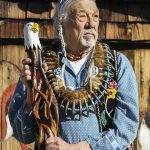
Hits: 1668
FALLON, Nev. — “It is difficult to miss Adam Fortunate Eagle Nordwall’s two-acre spread on the Paiute-Shoshone Reservation.
There, rising like a sacred temple out of the dusty brush, stand stacks of 5,000 fraying tires, reinforced with rusted cans and sand. They serve as the walls for what may be the first entirely recycled Native American roundhouse — even if it’s still only half-built after a decade.
“It’s a work in progress,” says Nordwall, 73, who admits the environmentally correct earth lodge is part fantasy, part folly. “One of these days, I’ll finish it.”
Fortunate Eagle, too, is a work in progress — or maybe just a piece of work. PROFILE: Adam Fortunate Eagle Nordwall »»
Mississippi Mound Builders
Mississippi Mound Builders were not limited to just the Mississippi River Valley. Ancient civilizations built mounds in a large area from the Great Lakes to the Gulf of Mexico and from the Mississippi River to the Appalachian Mountains, but the greatest concentrations of mounds are found in the Mississippi and Ohio River valleys.
These included societies in the Archaic, and Woodland period, and Mississippian period.
These Pre-Columbian mounds have been dated from roughly 3000 BCE to the 1500s, and most of these cultures lived in the Great Lakes region, the Ohio River region, and the Mississippi River region. However, there were also mound building cultures as far away as Florida.
Once it was thought all the mounds were built by one great ancient civilization. We now know that many different cultures contributed to the ancient mounds found on the North American continent. Mississippi Mound Builders »»
Standing Rock Sioux Reservation
- Views: 3129
The lands of the Standing Rock Sioux Tribe were reduced to a reservation by the Act of March 2, 1889. The Standing Rock Sioux Tribal members are descendants of the Teton and Yankton Bands of the Lakota/Dakota Nations.
The Great Sioux Nation is also called The Lakota Nation, Tetons and the Western Sioux. The people of the Sioux Nation refer to themselves as Lakota/Dakota which means friend or allie.
The United States government took the word Sioux from (Nadowesioux), which comes from a Chippewa (Ojibway) word which means little snake or enemy.
The French traders and trappers who worked with the Chippewa (Ojibway) people shortened the word to Sioux. Standing Rock Sioux Reservation »»
Roman Nose, Cheyenne war chief
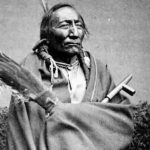
Roman Nose (c. 1823 – September 17, 1868), also known as Hook Nose (Cheyenne: Vóhko’xénéhe, also spelled Woqini and Woquini), was a Native American war chief of the Northern Cheyenne tribe.
He was called Môséškanetsénoonáhe (“Bat”) as a youth. He later took the warrior name Wokini, which the whites rendered as Roman Nose.
Considered invincible in combat, this fierce warrior distinguished himself in battle to such a degree that the U.S. military mistook him for the Chief of the entire Cheyenne nation.
He is considered to be one of, if not the greatest and most influential warriors during the Plains Indian War of the 1860s. Roman Nose, Cheyenne war chief »»
Quinault Indian Reservation
- Hits: 11530
The Quinault Reservation is located in Washington State on the Olympic Peninsula. It is home to the Quinault and Queets tribes and descendants of five other coastal tribes: Quileute, Hoh, Chehalis, Chinook, and Cowlitz.
The Quinault constitute one of numerous Washington State native american tribes designated as Coastal Salish people.
The Quinault Indian Reservation is a land of magnificent forests, swift-flowing rivers, gleaming lakes and 23 miles (37 kilometers) of unspoiled Pacific coastline. Its boundaries enclose over 208,150 acres (84,271 hectares) of some of the most productive conifer forest lands in the United States.
Located on the southwestern corner of the Olympic Peninsula, its rain-drenched lands embrace a wealth of natural resources.
Conifer forests composed of western red cedar, western hemlock, Sitka spruce, Douglas-fir, Pacific silver fir and lodgepole pine dominate upland sites, while extensive stands of hardwoods, such as red alder and Pacific cottonwood, can be found in the river valleys.
Roosevelt elk, black bear, blacktail deer, bald eagle, cougar, and many other animals make these forests their home. Quinault Indian Reservation »»
Cheyenne River Sioux Tribe of the Cheyenne River Reservation
- Views: 11546
Who are the Cheyenne River Sioux Tribe?
The Cheyenne River Sioux Tribe is made up of four bands of Sioux people: the Minneconjou, Two Kettle, Sans Arc, and Blackfoot Sioux.
Official Tribal Name:
Cheyenne River Sioux Tribe of the Cheyenne River Reservation Cheyenne River Sioux Tribe of the Cheyenne River Reservation »»
Treaty With The Comanche, Aionai, Anadarko, Caddo, Etc., 1846
Views: 8480
Treaty with the Comanches and other tribes. Articles of a treaty made and concluded at Council Springs in the county of Robinson, Texas, near the Brazos River, this 15th day of May, A. D. 1846, between P. M. Butler and M. G. Lewis, commissioners on the part of the United States, of the one part, and the undersigned chiefs, counsellors, and warriors of the Comanche, I-on-i, Ana-da-ca, Cadoe, Lepan, Long-wha, Keechy, Tah-wa-carro, Wi-chita, and Wacoe tribes of Indians, and their associate bands, in behalf of their said tribes, on the other part. Treaty With The Comanche, Aionai, Anadarko, Caddo, Etc., 1846 »»
Fort Peck Indian Reservation
- Views: 15521
The Fort Peck Reservation, headquartered in Poplar, is the second largest reservation in Montana, covering over two million acres of land.
Fort Peck Reservation is home to two separate Indian nations, the Assiniboine, and Dakota Sioux, each composed of numerous bands. There are an estimated 11,786 enrolled tribal members, of whom approximately 6,000 reside on or near the reservation.
The Assiniboine refer to themselves as “Nakona” and the Sioux call themselves “Dakota.”
The Sioux divisions of Sisseton/Wahpetons, the Yantonais, and the Teton Hunkpapa are all represented. The Assiniboine bands of Canoe Paddler and Red Button are represented and practice their culture and religion. Fort Peck Indian Reservation »»
An introduction to Hopi Basketry
Hopi basketmakers are some of the finest artists in this medium in North America. Today, while many Pueblo peoples no longer weave baskets, Hopi women continue a centuries-long tradition of basketry.
They are also innovative artists, developing new methods and designs from traditional ones.
Red, yellow, and black are the usual colors skillfully arranged to produce katsina, animal, blanket, and geometric designs.
The natural colors of plant materials used to construct the baskets serve as a background for the designs, constrasting with the vivid colors of commercial dyes.
The symbolism and tradition in Hopi basketry designs link each unique handmade basket to other parts of Hopi life, past and present. An introduction to Hopi Basketry »»
Harmful “Indian” Sports Mascots
As the nation’s oldest, largest, and most representative American Indian and Alaska Native advocacy organization, NCAI has long held a clear position against derogatory and harmful stereotypes of Native people—including sports mascots—in media and popular culture.
In 1968 NCAI launched a campaign to address stereotypes of Native people in popular culture and media, as well as in sports. Since this effort began, there has been a great deal of progress made and support to end the era of harmful “Indian” mascots in sports.
NCAI’s position is clear, longstanding, and deeply rooted in our seventy years as a leading voice for Indian Country – we advocate for and protect the civil rights, social justice, and racial equity of all Native people in all parts of American society. Harmful “Indian” Sports Mascots »»
Trust fund regulations revised for heirs
The Department of Interior has revised regulations affecting the distribution of trust assets following the death of an individual Indian landowner.
A Federal Register notice published December 31, 2001, makes note of the regulations, which apply to the Office of Hearings and Appeals. The rules are intended to conform with similar standards finalized by the Clinton administration at the Bureau of Indian Affairs.
Known as probate, the distribution of assets to the proper heirs is one of the key duties of the Interior. It is also one of the most backlogged areas of trust at the Interior and a significant trust reform project.
Despite the recognition of the problem, a senior trust officially recently testified that there are 14,000 cases that have yet to be resolved, more than twice the number that were known almost two years ago. The backlog results in delays of payment to Indian beneficiaries. Trust fund regulations revised for heirs »»
You can be a Modern Day Hero – Support Leonard Peltier’s Annual Christmas Drive
- Views: 1298
Indigenous Political Prisoner, Leonard Peltier, has organized his annual gift drive for the children of the Pine Ridge Lakota Nation in South Dakota. This is one way Leonard continues his humanitarian work for his people despite his incarceration.
Help Leonard Peltier reach out beyond the bars that imprison him.
You can send gifts such as new toys and practical, new winter clothing (gloves, jeans, thermal underwear, sweaters, socks, hats, scarves, jackets, boots, and blankets, etc,) to the addresses listed below. Your gifts will be distributed to the people of Pine Ridge in Leonard’s name.
Thanks to Peltier’s supporters, last years gift drive was very successful. Many families wrote Leonard to both thank him and tell him how the gifts brightened the families’ holidays.
Some supporters collected donations from stores who were willing to help after learning that Pine Ridge continues to be the most impoverished community in the United States. Some organized collections by asking friends and co-workers to sponsor a child by contributing a gift. Others simply purchased gifts out of pocket. You can be a Modern Day Hero – Support Leonard Peltier’s Annual Christmas Drive »»
Are Dream Catchers Losing the Native Tradition?
- Views: 3189
Though some tribal members say they see no problem with the practice, others regard the marketing of dream catchers as another example of their culture being picked apart.
When Millie Benjamin was growing up, she spent her nights sleeping under a dream catcher, a traditional Indian object believed to ward off nightmares.
Benjamin drew comfort from her dream catcher. These days, though, she shakes her head to see them worn as earrings, hanging from car windshields and even sold as key chains in convenience stores.
“It has gotten out of hand. It’s disrespectful for our people. It means something to us, it’s a tradition,” said Benjamin, a member of the Mille Lacs Band of Ojibwe.
Benjamin isn’t the only American Indian dismayed by the marketing of dream catchers. Though some tribal members say they see no problem with the practice, others regard the marketing of dream catchers as another example of their culture being picked apart. Are Dream Catchers Losing the Native Tradition? »»
Pueblo family forced to bury twice
The family of a deaf Laguna Pueblo woman was forced to hold two burial ceremonies for her because of a state oversight.
Alicia Waseta, 21, was dragged to death last September as she was crossing a street near the New Mexico School for the Deaf in Santa Fe, where she had recently graduated.
Her body was returned for burial later in the month but the state Office of the Medical Investigator (OMI) didn’t inform the family that her heart had been taken out.
The family found out two months later when an OMI employee called to ask if the agency could keep Waseta’s heart for medical research. Pueblo family forced to bury twice »»
How Dog Came to Be, An Ojibwe oral story
Views: 2246
They carried their canoe into the forest, turned it upside down, and hid under it. While they lay there shivering with fear and wondering what to do, they heard a crash and felt the earth tremble.
Then they heard a deep voice saying, “Neekaunssidog (brothers), don’t be afraid. I am Giant. I will not harm you.”
Why birds go south in winter
Views: 1970
Ojibwe Legend
Long ago there was only summer. The days were always warm and sunny. Winter and snow were unknown.
For the young it was a time of happiness. They played all the time. Animals played with animals. Fish played with fish. Insects played with insects. Birds played with birds.
They had many games — hide-and-seek, blind-man’s buff, and tag. They ran races, they wrestled, and they played lacrosse. The lakes, the meadows, and the skies rang with their laughter.
From dawn to dusk the young played. No sooner had they finished one game than they began another. They ate little and rested even less. For the parents it was a time of worry. All they could do was try to keep their offspring from harming themselves. Only nighttime brought rest. Why birds go south in winter »»
Turtle Mountain Indian Reservation Overview
Hits: 2003
Although the Turtle Mountain Indian Reservation is known as home to the Turtle Mountain Band of Chippewa Indians, there are also members of the Pembina Band of Chippewa living there.
Most of the Chippewa in this area are of mixed ancestry, predominately French and are known as Mechif/Metis. Few full blood Chippewas remain.
According to the 1990 Bureau of Indian Affairs estimates, tribal membership is approximately 25,000. Turtle Mountain Indian Reservation Overview »»
How to make a Corn Husk Doll
This adorable native american corn husk doll makes an easy and entertaining kid’s craft project and is also fun for adults decorating with Thanksgiving craft projects.
Age Appropriate: K-6
What you’ll need to make a cornhusk doll:
9-12 pieces of green corn husk
String or twine
Decorative pieces
Scissors
Bowl of water
Glue
Stand Waite, last major Confederate field commander to surrender to the Union
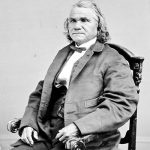
Stand Watie became the last major Confederate field commander to surrender to the Union, on June 23, 1865, which took place at Doaksville, in the Choctaw Nation, Indian Territory.
Watie, a Cherokee, was the only Native American on either side in the Civil War who attained the rank of brigadier general.
Stand Watie’s surrender came 75 days after Robert E. Lee’s to Ulysses S. Grant at Appomattox, Virginia, 66 days after Joe Johnston’s to William Tecumseh Sherman, at Bentonville, North Carolina, and 21 days after Trans-Mississippi Department head Edmund Kirby Smith’s to E. R. S. Canby at Galveston, Texas.
Himself a slave-owner of African-American plantation slaves, Watie was a diehard Lost Cause southerner. Stand Waite, last major Confederate field commander to surrender to the Union »»
Assiniboine Chief Crazy Bear
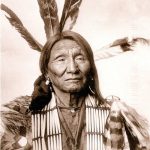
Crazy Bear (Mah-To-Wit-Ko, also known as Foolish Bear, 1785–1856) was an Indian chief of the Assiniboine tribe. He is best known as a skilled negotiator with the American Fur Company at Fort Union, North Dakota; and for his participation and representation at the Fort Laramie Treaty Council of 1851—where he was a signatory of the treaty. Assiniboine Chief Crazy Bear »»
The Legend of Devil’s Tower
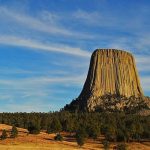
Out of the plains of Wyoming rises Devil’s Tower. It is really a rock, visible for a hundred miles around, an immense cone of basalt which seems to touch the clouds.
Devil’s Tower sticks out of the flat prairie as if someone had pushed it up from underground.
Of course, Devil’s Tower is a white man’s name. We have no devil in our beliefs and got along well all these many centuries without him. You people invented the devil and, as far as I am concerned, you can keep him. The Legend of Devil’s Tower »»
Lakota Star Knowledge
The Lakota constellations are visible in the winter sky, and they reflect Lakota mythology. A notable aspect of that mythology is that every event and object on earth has a correspondent in the sky. Lakota Star Knowledge »»
Create your own reality – A Sioux Legend
The Creator gathered all of creation and said, “I want to hide something from the humans until they are ready for it. It is the realization that they create their own reality.” Create your own reality – A Sioux Legend »»
Reno linguist foremost expert on Washoe language
William H. Jacobsen Jr. is recognized as the foremost expert on the ancient and complex language of the Washoe tribe that has occupied Carson Valley and surrounding areas for thousands of years. Reno linguist foremost expert on Washoe language »»
Zuni Men of the Early Times
Eight years was but four days and four nights when the world was new. It was while such days and nights continued that men were led out, in the night-shine of the World of Seeing.
For even when they saw the great star, they thought it the Sun-father himself, it so burned their eye-balls.
Men and creatures were more alike then than now…
Coyote and Eagle Steal the Sun and Moon
Back when it was always dark, it was also always summer. One day, Coyote and Eagle went hunting. Coyote was a poor hunter because of the dark.
Eventually, they came to the Kachinas, a powerful people. The Kachinas had the Sun and the Moon in a box.
After the people had gone to sleep the two animals stole the box. At first Eagle carried the box but Coyote convinced his friend to let him carry it.
The curious Coyote soon opened the box and the Sun and Moon escaped and flew up to the sky.
This gave light to the land but it also took away much of the heat, so we now have winter.
The Seneca Confederacy
The Seneca Confederacy included the Erie, Conestoga, Cayuga, Oneida, Mohawk, Onondaga, Tuscarora, and Wyandot. The Stockbridge were also known as the Housatonic and were united with the Oneida. The Seneca Confederacy »»
Burr Woman
Long ago, there lived a very handsome youth. All the girls were eager to marry him, but he did not care for women. There was a good-looking girl who was living with her grandmother. She proposed to the youth, but he refused to marry her. The girl returned and complained to her grandmother. Burr Woman »»
Joe Leaphorn is not his old self but Tony Hillerman is happy with ‘Skinwalkers’
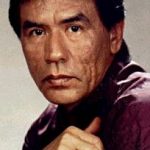
The Navajo police lieutenant from 14 Tony Hillerman novels has been altered for television. But his creator is pleased with what he sees.
Wes Studi, who plays Leaphorn in “Skinwalkers” as the new PBS Mystery season gets under way Sunday (9 p.m. EST), must share credit for the novelist’s pleasure with director Chris Eyre and writer Jamie Redford, son of Robert Redford (who’s the executive producer).
Instead of the wise, patient and culturally sensitive sleuth of literature, the Leaphorn of the first U.S.set episode of the previously all-British Mystery series is redrawn as a grouchy urban cop who has lost touch with his Navajo roots and returns to the reservation with his ailing wife. Joe Leaphorn is not his old self but Tony Hillerman is happy with ‘Skinwalkers’ »»
How a White Man Became an Indian
Not so very long ago there was to be found living in the far West a quaint old man. He had seen many moons. His head was almost white from the frosts of some seventy winters. He was a Wyandot Indian, and he lived with his own people.
His house stood among the trees by a clear, swift river in the beautiful hills. At a great city far from his home he had some land. This land was worth much money. Some mean white men were about to take the land away from him. But a kind white man made them pay the Indian what the land was worth. How a White Man Became an Indian »»
Wyandotte (Huron) Creation Legend and How the Sun was Made
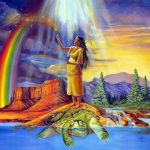
In the beginning, the people were all Wyandots. They lived in Heaven. Hoo-wah-yooh-wah-neh, The Great Spirit or mighty chief, led them. Wyandotte (Huron) Creation Legend and How the Sun was Made »»
Glooscap: Origin of the Medicine Man
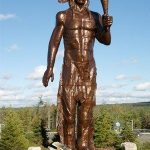
The Medicine Man is Glooscap, the Good-Spirit. Legend has it that the father of Glooscap is a being who lives under a great waterfall beneath the earth.
His face is half-red, and he has a single all- seeing eye. He can give to anyone coming to him the medicine he desires. Glooscap: Origin of the Medicine Man »»
Cherokee Wedding Attire
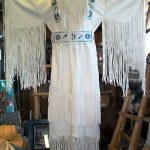
For a Cherokee wedding, the bride wears a special style of dress called a “tear dress.” The groom wears a ribbon shirt and black slacks. They both wear moccasins. In lieu of rings, the bride and groom exchange gift baskets. Cherokee Wedding Attire »»
We must honor the buffalo! We are buffalo people.
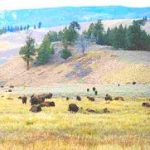
Many days passed before the joy of that day settled deeply into my heart and I could move forward to thinking on the realities of the present situation of the buffalo on our People.
The senseless slaughter of 60 million buffalo brought the herds to the point of extinction. We must honor the buffalo! We are buffalo people. »»
We are all one family: Buffalo and Native Americans
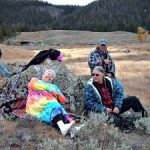
As we completed our prayers, we all sat there with the buffalo herd in silence. The buffalo had been making their low, gentle calls back and forth to each other during the entire time we had been praying and singing for and with them. Yet at the end of the prayers, we all, as one family, sat in peace and silence together.
Slowly the real world began to slip back into the moment and the sounds of bustling tourists and cars crept back into the present. And then, as is most often the case with our Native relatives, the laughter began. Gentle teasing and loving laughter went back and forth between us all and we slowly began our journey back to the parking area. We are all one family: Buffalo and Native Americans »»
What the buffalo mean to Native Americans (our people)
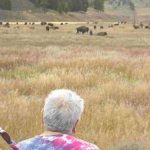
One breath at a time and one second at a time adds together to a life well lived or one filled with sadness at missed opportunities to make the world a better place. On this September day there was peace, prayers, songs and the drum joining together with the buffalo and humans in a meadow where time seemed to stand still. What the buffalo mean to Native Americans (our people) »»
Pray for the Buffalo
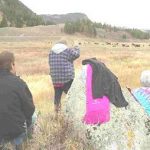
In September 2007, there were six devoted people who did not forget the buffalo. Though the day was cold and the sky filled with snow, the journey began into the heart of Yellowstone in search of our beloved buffalo.
Three men and three women began the day amidst the traffic, stopping at gas stations, passing through forest ranger stations and dealing with the congestion of Yellowstone Park visitors to arrive at the place where one of the buffalo herds was gathered. Pray for the Buffalo »»
A Day with the Buffalo and the Elders

In beginning this story, let us all back up and take time to learn about the buffalo and why they are sacred to the Native people.
As is our tradition, listening to the oral history from a trusted Elder is how we learn our history and deepen our respect for our culture and the legacy of those who have come before.
I am honored to share this story as told by Scott Frazier, Santee/Crow, as told to him by his Grandfather. A Day with the Buffalo and the Elders »»
Tribal descendant wins fight to retreive hair
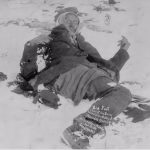
Last summer, in the countryside near Oglala, Leonard Little Finger held a lock of hair in his hands and knew the agony of Wounded Knee.
He and six others had just returned from New England, where they had claimed a lock that reportedly had been cut from the scalp of his great-great-grandfather, Chief Big Foot, more than a century earlier at the Wounded Knee massacre.
For decades, it had been part of a library collection in Barre, Mass. Now, as Little Finger prepared to return it to Mother Earth, he believed that he could almost hear the cries of the more than 250 Lakota men, women and children slaughtered on Dec. 29, 1890, by the Seventh Cavalry.
“Even though 110 years had gone by, I felt like I had become part of what happened,” Little Finger, 61, says from the Loneman School in Oglala, where he is director of Lakota Studies.
“It was kind of awesome,” he says. “All of a sudden, here is something that is a physical part of that massacre. And it’s like it puts you right into it.”
That he was given the hair at all speaks to a dramatic shift in societal attitudes the past 20 years.
Tribal remains and artifacts once routinely sought out for museums, classrooms and private collections now are being returned en masse to the lands and people from which they came.
Legal shifts
Several federal laws have hastened that return, or at least stemmed their removal from the land.
Protection of Native American sacred places fact sheet
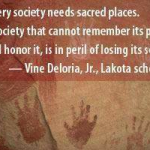
Native American sacred places are where Native Peoples who practice their traditional religions go to pray for the good day, the precious earth, the blessing waters, the sweet air and peaceful life for all living beings the world over. Protection of Native American sacred places fact sheet »»
Natives celebrate return of sacred bundle: Spirits Back Home
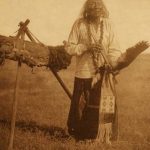
Spirits are being awakened for the first time in 60 years.
I can see it in the faces of those around me, Blackfoot Indians from both sides of the border, gathering on Canada Day at a ranch in northern Montana to celebrate the return of a vital link to their past.
The men sit nearest the fire, the women forming a circle behind them. Sweetgrass burns and turns to ash, filling the teepee with an ancient aroma.
Expressions filled with reverence and awe, their attention is fixed on a metre-long stone and reed pipe, decorated with the mummified head of a harlequin duck on one end, and a fan of eagle feathers on the other. Natives celebrate return of sacred bundle: Spirits Back Home »»
The Buffalo Dance
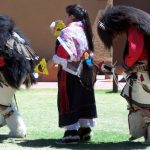
The Buffalo Dance, of course, revolves around the buffalo, more correctly known as the American Bison. The buffalo is a symbol of abundance.
Historically, Pueblo Peoples crossed the mountains to the north to hunt or trade for buffalo and bring back meat for the long winter. The Buffalo Dance »»
Acoma Indian Reservation
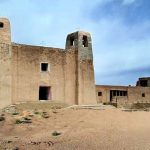
The Acoma Indian Reservation is located in parts of Cibola, Socorro, and Catron counties in New Mexico, USA. This reservation covers 594.996 sq mi (1,541.033 km²). The Acoma Pueblo is the heart of the reservation and is the oldest continuously inhabited place in the United States. Acoma Indian Reservation »»
Indian symbols used on the hunting horse
Since the Indian hunting horse had different duties than that of a war horse, a different set of symbols were used to aid the hunting horse and his rider.
Designed to help the Indian hunter in finding the buffalo herd, many of these symbols also brought favor from the Great Spirit. Indian symbols used on the hunting horse »»
How much financial support do Indians get from the federal government?
Question:
I am in my first year of college and I am currently trying to formulate a paper on the lack of support from the American government to the Native American community.
I would like to know what kind of benefits they offer people living on a reservation, and/or how often tribes get financial support from the government in order to make up for the lack of natural resources on the tribe’s “given” land.
I would really appreciate it if you got back to me A.S.A.P. I need to start my page.
–Submitted by Kayla B. How much financial support do Indians get from the federal government? »»
Sioux Indian Prayer: Teach us to walk the soft earth
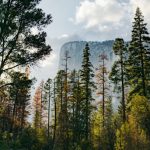
Great Spirit,
Teach us to walk the soft earth as relatives to all
that live. Sioux Indian Prayer: Teach us to walk the soft earth »»
Zuni tradition lives in fetishes
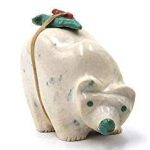
Zuni fetishes are more than just art. The Zuni consider the things least understood and most mysterious to be the most sacred and powerful.
Because animal ways can never truly be understood, animals represent those unknown powers.
To them, those powers can be transferred to diminutive animal carvings known as fetishes. Zuni tradition lives in fetishes »»
Eyre returns with “Skins”
Bristling with anger, humor and a deep sadness, Chris Eyre’s second feature “Skins” is a torrent of moods, feelings and scorched fury.
In examining a struggle of acceptance and reconciliation between two brothers, the film acknowledges a culture whose scarred past and uncertain future remain inchoate and incomplete. Eyre returns with “Skins” »»
Blackfeet / Blackfoot Subdivisions and Bands
The Blackfeet / Blackfoot tribes were divided into the following divisions: The Siksika or Blackfeet proper, occupying the northern part of their territory; the Kainah or Bloods south of the preceding, and the Peigan or Piegan, south of the Kainah, the one best represented in the United States. Here is a chart of the bands that made up each division. Blackfeet / Blackfoot Subdivisions and Bands »»
Places to Visit Native American Culture Exhibits in Oklahoma USA
Here is a list of places to visit Oklahoma Native American Culture exhibits: museums, libraries, Heritage Centers, Living History Towns, and more.
The A.D. Buck Museum of Natural History & Science
1220 E. Grand
Tonkawa, OK 74653
mailing address:
P.O. BOX 310
Tonkawa, OK 74653
tel (405) 628-6200
fax (405) 628-6209
Ataloa Lodge Museum, Bacone College
Bacone College, Muskogee (74403)
Features Indian arts and crafts. School is famous for its Indian Art School. Graduates include Willard Stone, Woody Crumbo, Acee Blue Eagle, Terry Saul and Solomon McComb
Phone # 918-781-7283
The Anadarko Philomathic Museum
311 E. Main St.
Anadarko, OK 73005
tel (405) 247-3240 Places to Visit Native American Culture Exhibits in Oklahoma USA »»
Blackfoot names used by other tribes
Each Indian tribe had their own word to mean the Blackfoot Tribe. Here is a list of a few of the names given the Blackfoot by other Indian tribes: Blackfoot names used by other tribes »»
Places to visit Native American culture exhibits in Michigan
List of Native American culture exhibits in Michigan such as art, geology, museums, living history, and more.
Andrew J. Blackbird Museum
368 E. Main St.
Harbor Springs, MI 49740
mailing address:
P.O. BOX 192
Harbor Springs, MI 49740
tel (616) 526-7731
fax (616) 526-7731
Center for Cultural and Natural History
Bellows St.
103 Rowe Hall
Mount Pleasant, MI 48859
tel (517) 774-3829
fax (517) 774-3542
Chippewa Nature Center
400 S. Badour Rd.
Rte. 9
Midland, MI 48640
tel (517) 631-0830
fax (517) 631-7070 Places to visit Native American culture exhibits in Michigan »»
Seminole Homes are called chickees
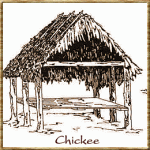
Seminole Indians and other South Eastern tribes lived in a home called a Chickee. A chickee was a house built on stilts usually about three or four feet above the ground. A chickee was usually about nine feet wide and sixteen feet long, with a wooden platform which served as the floor and a thatched roof. Seminole Homes are called chickees »»
Red Earth Pow Wow Championship of Champions Contest
Each year the Red Earth Pow Wow holds a Men’s Fancy Feather contest dance competition. Through out the years the Pow Wow committee developed a competition of former winners of Red Earth Pow Wow Fancy Feather Contest and it’s called the Championship of Champions. Watch a video of these champion dancers. Red Earth Pow Wow Championship of Champions Contest »»
Denver March Pow Wow Grass Dance Finals Video
The final three song set of the Denver March Pow Wow Grass Dance Finals in 2011 goes to overtime with an extra song to determine a winner for the title. The Powwow features more than 1,600 dancers from close to 100 tribes from 38 states and three Canadian provinces. Denver March Pow Wow Grass Dance Finals Video »»
What is a pow wow?
A Pow Wow is a gathering where Native American dancing, singing and celebration take place. There are dozens of different pow wows that take place throughout the country in all seasons of the year, but the most popular pow wow season is summer in the Northern US and winter in the Southern states. What is a pow wow? »»
History of the Modern Pow Wow
The history of the modern pow wow is always evolving. Competitive singing and dancing for prize money is a recent change in the traditional pow wow.
Prize money is awarded to top point-getters at the culmination of the event for both dancing and singing/drumming competitions. History of the Modern Pow Wow »»
Rules for the pow wow judges
The selection of the pow wow judges is very important to ensure a successful pow wow. At most pow wows the head judges are selected by the Pow Wow Committee; they may also recommend singing and dancing judges. Rules for the pow wow judges »»
The Grand Entry
Although pow wows may differ, depending on the location or type, and the exact order may be different, the Grand Entry usually starts off the festivities.
Here is the usual order at Northern Pow Wows. The Grand Entry »»
Contest rules and regulations for pow wow singers, also known as drum groups.
Different pow wows have different rules and regulations which they follow to govern their celebration. Some are old and have been in place for hundreds of years, while others may be fairly new and are in a constant state of modification. Here are the general rules and regulations for pow wow singers, also known as drum groups. Contest rules and regulations for pow wow singers, also known as drum groups. »»
Pow Wow Rules for Dancers
Each pow wow has a set of pow wow rules for the dancers competing for prize money. These are the general pow wow rules in effect at most pow wows. Pow Wow Rules for Dancers »»
Pow Wow Participants
Pow Wow participants include dancers and drums from tribes throughout the United States and Canada, who participate in the hundreds of pow wows and Native American celebrations each year. They come from every state in the Union and every province of Canada. At times, even participants from the Native tribes of South America participate. Pow Wow Participants »»
The Powwow committee
Pow wows are the result of a lot of hard work done by many dedicated people who work for an entire year to make sure that it is successful. The Powwow committee »»
The Drum
Drums can come from a variety of sources. Some are handed down in a family; others are donated to a drum group. Older drums are made of deer, elk or horse hides, but contemporary bass drums can be purchased or renovated, and even blessed, just as are the older drums. The Drum »»
The Drum »»
Special Pow Wow Songs include the Flag Song, Honor Songs and Trick Songs
Several types of special songs are included in native American pow wows, including the Flag Song, Honor Songs, and Trick songs. Special Pow Wow Songs include the Flag Song, Honor Songs and Trick Songs »»
Host drums and drum groups
Music for pow-wow dance competitions and other activities is provided by a “Drum,” which is a closely knit group of singers who play a large, specially designed drum and sing traditional songs. They are also often called a Drum Group. Host drums and drum groups »»
Men’s Traditional Dance
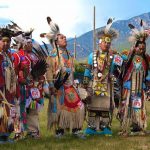
The men’s traditional dance is just that: a traditional dance held over from times when war parties would return to the village and dance out the story of the battle, or hunters would return and dance their story of tracking an enemy or prey. Men’s Traditional Dance »»
Stone Mountain Park – Indian Festival and Pow Wow
The Stone Mountain Park Indian Festival and Pow Wow is billed as the largest Indian festival and pow wow in Georgia. This four day event, starting on Thursday and concluding on Sunday is a great family experience. Stone Mountain Park – Indian Festival and Pow Wow »»
Hawaii powwows and native Hawaiian events
Find out where to attend powwows and other native Hawaiian events in Hawaii. Learn powwow etiquette, dances, terminology, vendor information, and more.
NARA’s 34th Annual New Year’s Eve Sobriety Powwow
An annual New Year’s Eve Sobriety pow wow is sponsored each year in Portland, Oregon to ring in the new year. NARA’s 34th Annual New Year’s Eve Sobriety Powwow »»
Anishnawbe Four Directions Song
Lyrics and English translation of Anishnawbe Four Directions Song. The video lyrics are in the native language. Anishnawbe Four Directions Song »»
Men’s Fancy Dance
The Fancy Dance is a relatively new dance. The brilliantly colored feather bustles are said to have originated in Oklahoma in the early 1900s when promoters of large Native American ceremonials asked dancers to beautify their outfits for the spectators. Men’s Fancy Dance »»
Men’s Grass Dance
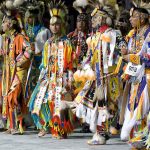
Much has been written about the Grass Dance. Borrowed from the Omaha tribe, perhaps in the 1860s, this dance is very popular. Dancer’s outfits feature a good deal of colorful fringe, replacing the grasses dancers originally tucked into their belts. Men’s Grass Dance »»
Sneak Up Dance
The Sneak-Up Dance is an ancient storytelling dance having several origins, that became known as a Sneak Up Dance when it was performed in the Wild West Shows of the 1800s. Sneak Up Dance »»
The War Dance
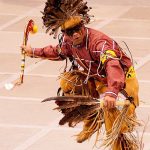
The War Dance cannot function as it once did, but it is one of the principal features of a pow wow. Traditionally, the War Dance was a major event in itself that was performed after a battle to record the brave feats performed in battle, or to prepare for an upcoming battle. The War Dance »»
Women’s Fancy Shawl Dance
The Women’s Fancy Shawl Dance is a relatively new addition to the pow wow dance competitions. Until fairly recently, women performed their fancy dancing in traditional garb. Women’s Fancy Shawl Dance »»
How the women’s Fancy Shawl Dance is Judged
The fancy shawl dance is a very aerobic, fast paced dance. Thus, this is usually considered a dance for the younger ladies and girls. However, dancers of any age may dance the fancy shawl dance, from babies to elders. How the women’s Fancy Shawl Dance is Judged »»
Different types of songs are sung for different pow wow events
Different types of songs are sung for different pow wow events—Grand Entries, dance contests and honoring ceremonies. Songs are made for all reasons. Although they differ in tempo, words and emotion, pow wow songs all follow a similar structure. Different types of songs are sung for different pow wow events »»
The Pow Wow Announcer, Arena director, and Head Dancers
The Pow Wow Announcer, Arena director and Head Dancers lead the pow wow activities and make sure the powwow runs smoothly. The Pow Wow Announcer, Arena director, and Head Dancers »»
Dance Regalia of the Fancy Shawl Dancer
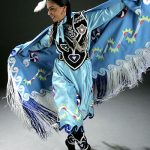
This article gives a general overview of the proper attire for a Fancy Shawl Dancer. Rather than the double-bustle the early Crow girls wore to dance the Fancy Dance, today’s Fancy Shawl dancer wears a dress made of a shiny fabric such as taffeta or satin. Dance Regalia of the Fancy Shawl Dancer »»
Crow explanation of how the ladies Fancy Shawl Dance competition began
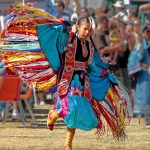
At Crow Fair in Montana, I was told another story about the Fancy Shawl Dance. While the Crow people also equate this dance form as an expression of re-emergence and renewal of life forces, they have a very different explanation of how it began. Their version goes like this: Crow explanation of how the ladies Fancy Shawl Dance competition began »»
Cherokee Butterfly Legend
Some say the modern day Pow Wow competition dance known as the Ladies Fancy Shawl Dance has its roots in a ceremonial dance called the Butterfly Dance. Here is a Cherokee account of how that dance came to be. Cherokee Butterfly Legend »»

